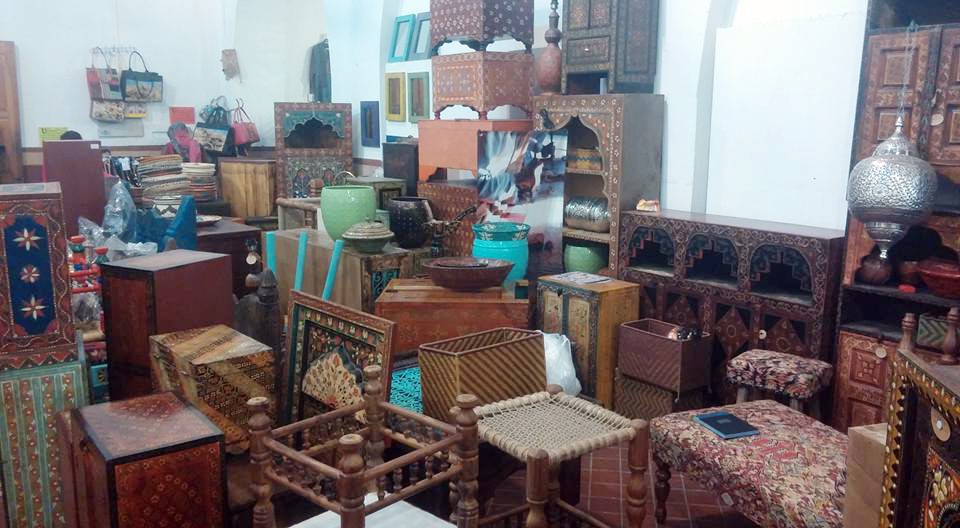
A colourful window into the country’s cultural heritage

The craft mela held at the Heritage Museum Lahore, formerly Tollinton Market, last weekend has almost become a biannual ritual for the city. It is perhaps time to assess its worth -- in promoting traditional arts and crafts.
While some people think it is too high class a mela promoting middlemen and NGOs more than actual craftspeople, others think this kind of avenue is crucial in order to introduce and showcase the design interventions that are eventually helping the craftspeople.
There are no two views about the success of the endeavour though where, this time again, many stalls exhibited traditional Kashmiri and Swati shawls, carpets, handmade woolen garments, semiprecious stones and silver jewellery, designer furniture, clothing, ethnic foods, photographic art, paintings, hand-turned wood, ceramics, gifts and collectibles, bath and spa items, accessories and antiques.
"Retail is turning out to be one of the fastest growing sectors in Pakistan but a structured retail platform is still a challenge for designers. Daachi has managed to not only establish that channel but also attained brand recognition and generate a foot fall for Pakistani craft," said a very passionate Sahar Atif, a key member of Daatchi team and a designer in her own right.
The blue ceramic Multan pottery including intricately-designed platters, serving dishes and vases drew shoppers like bees to honey. The kashikari tea trolleys and tray along with terracotta products, and exquisite naqshi work which is a dying art of embellishing surfaces allowed the visitors to reconnect with the masterful art pieces made by deft hands.
The main attraction among the handicrafts here included paper mâché, wood carvings, ari work which have been handed down through generations but were losing their significance. "We want people from outside to come and visit such exhibitions. The handicrafts from Pakistan are known throughout the world for their inventiveness and splendour,’ said Ayesha Noorani, chairperson Daachi Foundation and the brains behind the venture.
"The idea is the revival and promotion of traditional crafts, provide opportunities to craftsmen and entrepreneurs and to celebrate the ideology and culture of Pakistan. Such exhibitions help create awareness about the arts and crafts which the new generation doesn’t know much about," she said.
The Daachi’s future plans surely look promising as they plan to set up various crafts villages in different parts of the country to boost traditional handicrafts of these regions. The idea does not seem too farfetched as they have already acquired a land near Raiwind in Lahore. The daachi artisan village being planned will feature shops, stalls, art and museum gallery, workshop, performance area, residence for craftsmen and a food court offering freshly cooked ethnic food, hygienic and reasonably priced.
"We want to inculcate a sense of pride in people of their identity and educate about our history and origin by staging plays and performances there too,’ said Noorani.
"This is craftsmanship at its finest. I thoroughly enjoyed looking and buying as much as my hands could carry. It was unreal to see all of this in one place. Hats off to the organisers and I really feel I missed out by not at being the previous ones," said talented fashion designer Saman Arif of Nayna.
This was the second Daachi mela for Zahra Ebrahim, who along with Rubain Ali Aamir, bring their home furnishings from Karachi. Both times they have received a rousing response from Lahoris. "I find Daachi to be an interesting platform where craftsmen and designers collaborate with each other and add value -- by enhancing beauty and refinement to products unique to Pakistan."
Also, Ebrahim felt, this mela at Tollinton is a great meeting place for people related to the design and crafts industry, where people share tricks of trade with each other. "Last time I met a craftsman who works with brass to create the most exquisite products. He taught me the technique of applying lacquer that I have begun to use while finishing my products." Likewise, last time, she met a ceramist who brings beautiful ceramic birds to the mela. She has incorporated his birds in her designs this time. "It must have brought joy to the ceramist to see how I used his craft."
Usama Saeed, the proprietor of Lahori Ink a local enterprise said, "You won’t get such strong sales points anywhere else and every item’s price has been slashed for this event. It was a joy to set up my stall here as it gave me an ideal backdrop to connect and touch base with my clients."
"I had received good response from customers, whose numbers kept increasing as the word spread about," said Saima Shiraz of Al hams gallery whose phulkari coats were a rage with customers. Such was the interest around her small kiosk that at one point the organisers came to her and inquired if she was selling the items for free. She admitted to having been inquired by a party from Italy who was interested in bulk supply thereby giving her an order of 100 coats.
"This is not an uncommon drift and happens always at Daachi especially in goods like textiles, handicrafts and leather products. I am expecting a total sell-out," observed a very contented Noorani.
The turnout at Daachi was an evidence of the success of the event and the demand for local craft.